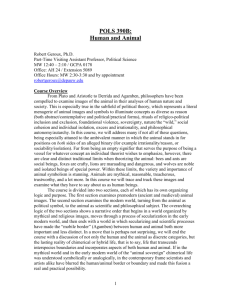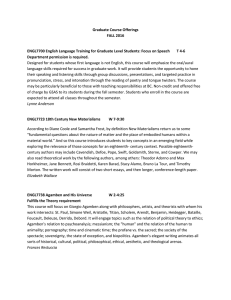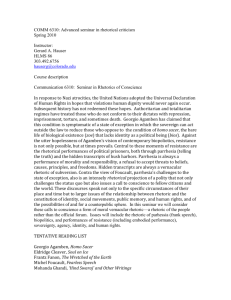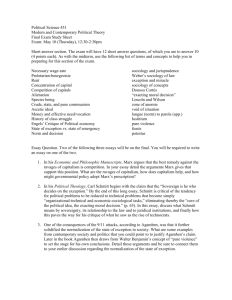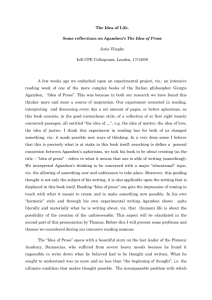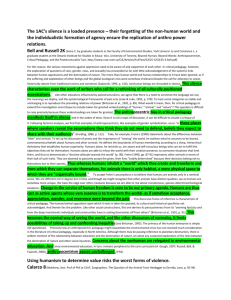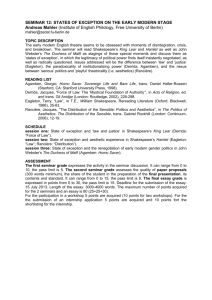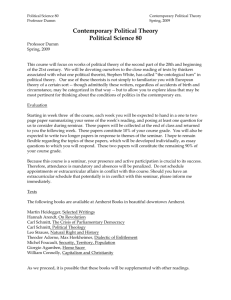Of Mites and Men: Animality, Bare Life and the
advertisement
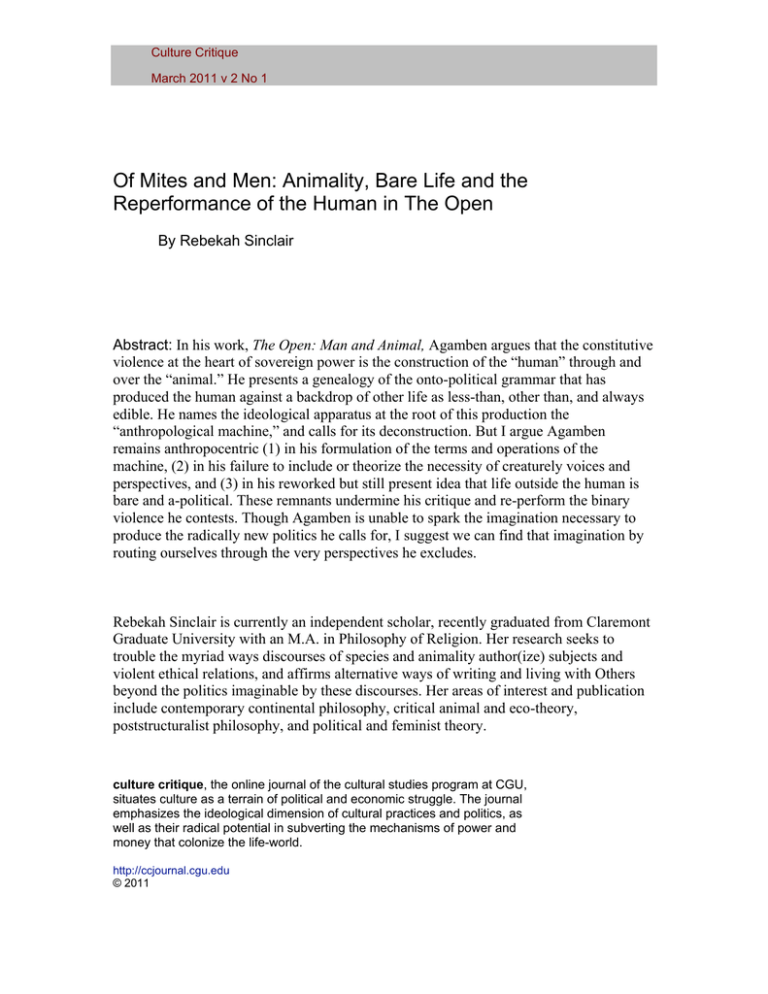
Culture Critique March 2011 v 2 No 1 Of Mites and Men: Animality, Bare Life and the Reperformance of the Human in The Open By Rebekah Sinclair Abstract: In his work, The Open: Man and Animal, Agamben argues that the constitutive violence at the heart of sovereign power is the construction of the “human” through and over the “animal.” He presents a genealogy of the onto-political grammar that has produced the human against a backdrop of other life as less-than, other than, and always edible. He names the ideological apparatus at the root of this production the “anthropological machine,” and calls for its deconstruction. But I argue Agamben remains anthropocentric (1) in his formulation of the terms and operations of the machine, (2) in his failure to include or theorize the necessity of creaturely voices and perspectives, and (3) in his reworked but still present idea that life outside the human is bare and a-political. These remnants undermine his critique and re-perform the binary violence he contests. Though Agamben is unable to spark the imagination necessary to produce the radically new politics he calls for, I suggest we can find that imagination by routing ourselves through the very perspectives he excludes. Rebekah Sinclair is currently an independent scholar, recently graduated from Claremont Graduate University with an M.A. in Philosophy of Religion. Her research seeks to trouble the myriad ways discourses of species and animality author(ize) subjects and violent ethical relations, and affirms alternative ways of writing and living with Others beyond the politics imaginable by these discourses. Her areas of interest and publication include contemporary continental philosophy, critical animal and eco-theory, poststructuralist philosophy, and political and feminist theory. culture critique, the online journal of the cultural studies program at CGU, situates culture as a terrain of political and economic struggle. The journal emphasizes the ideological dimension of cultural practices and politics, as well as their radical potential in subverting the mechanisms of power and money that colonize the life-world. http://ccjournal.cgu.edu © 2011 Culture Critique March 2011 v 2 No 1 The human/animal distinction is a central problem facing contemporary politics. The construction of subjects as “human” or “animal,” whether through clandestine metaphysics or scientific discourses of species, keeps in tact the social, economic, material, political and linguistic mechanisms that violently build and exclude subjects. If post-essentialist or posthuman ethico-politics hope to affirm novel alternatives to their predecessors, they must remain vigilantly attentive to lingering human/animal divisions and their consequences. Given the necessity, but rarity, of such attention, Agamben’s 2004 publication, The Open, marks one of his most original contributions to political theory. His previous work argued that the founding operations of sovereign power lie in the organizing principles by which it produces and conceals what counts as political life or a-political life in the first instance. But in The Open, Agamben finds that this political/a-political distinction is made possible by the discourses of the human and the inhuman. i At the heart of sovereign power lies anthropocentrism—the network of onto-political grammars that ceaselessly produce and exclude “animal life” from the political. The Open traces the ways sovereign power has used the human/animal distinction to produce the categories of bare life and homo sacer that allow for depoliticization and unchecked violation. Agamben argues that in order to imagine alternatives to Statal, juridical, and sovereign power, one must first jam this "anthropological machine." My interest in Agamben is born of my respect for this important contribution to political theory, and for his willingness to be critical of the anthropocentrism and violence that acts as the locus of identity for “humans,” and perpetuate real violence against real lives. And I agree that deconstructing human/animal distinctions is necessary 1 Culture Critique March 2011 v 2 No 1 if we are to takes seriously the consequences of a vulnerable and exposed subject, and imagine new ethical possibilities and new ways of being-with. But unlike Agamben, who is primarily and unapologetically attentive to the consequences of this binary on the “human,” I am primarily, and with equal tenacity, attentive to the consequences on those we call “animal.” From this perspective, I argue that Agamben reperforms the anthropocentrism he contests. Since these remnants will stymie our mutual goal of deconstruction, I offer the following criticisms from a place of camaraderie and a shared hope for a radically less violent future. In the following, I will draw on Agamben’s earlier readings of sovereign power, the homo sacer, and bare life to trace his formulation of the anthropological machine and its centrality in the creation and deconstruction of sovereign power. I then argue that Agamben’s project remains anthropocentric in (1) its formulation of the terms and operations of the machine, (2) its failure to include or theorize the necessity of creaturely voices or perspectives, and (3) its retention of the idea that life outside the human is bare and a-political. ii I begin my critique by arguing that Agamben’s formulation of the anthropological machine has (1) anthropocentric, (2) reductionist, (3) reperformative political implications. Agamben’s deconstruction remains anthropocentric (in name and deed) by failing to re-orient the subject to something other than animality. Further, the machine, in its inherent unity and singularity, is a surprisingly totalizing metaphor. The problems of this metaphor are mirrored in Agamben’s work, as he fuses fragmentary, divergent, and irreducibly particular discourses under the assumption of a singular, anthropocentric, unifying economy. By being primarily attentive to the ways the binary 2 Culture Critique March 2011 v 2 No 1 affects the human, Agamben misses the moment of reperformance, where the terms and evidence he would use to disrupt the anthropocentric signifying economy reperform its violation. I then argue that Agamben’s method of deconstruction maintains anthropocentrism’s founding gesture by failing to address the machine with adequate attention to, or from the perspective of, the excluded creatures. Instead, Agamben is primarily attentive to the ways the economy delimits human political possibilities and vicissitudes. Even when animal Others do figure into his deconstruction, they serve as what Guyatri Spivak might call “native informants”; they are interrogated through experiment and observation, as though their answers might show the “real” behind the veil of the binary. By not including or imagining the multiple voices and perspectives of creatures other then the human—whose identity he contests—Agamben reperforms the terms of the binary, the inside and outside, and perpetuates the fantasy of Otherness. Finally, I will trouble Agamben’s claim that the death of the machine makes bare life the center of politics. Agamben claims that to deconstruct the human and animal is also to dismantle the tools the sovereign uses to politicize and depoliticize life. In a postmachine world, life itself becomes the sole object of politics. Agamben imagines an irreparable and vulnerable community of bare life—life that no longer needs to be saved by human political valuation and regulation. But I argue that his formulation of bare life reasserts the anthropocentric assumption that life outside the human political is without its own politics, intentionality, and value structures. He overlooks the possibility that other lives already have complex ethics and politics, and that cultural signification 3 Culture Critique March 2011 v 2 No 1 happens across all micro- and macrocosms of existence. He therefore also misses whatever radical political possibilities these Others might offer us. Sovereign Power and the Making of the Machine The resources for understanding both the framework of the anthropological machine, and how animality comes to be the defining political problem for Agamben, can be found in his earlier work, Homo Sacer: Sovereign Power and Bare Life. iii There, Agamben traces the operations by which life is depoliticized through the four duplicitous structures and manifestations of sovereign power. According to Agamben, we have misconceived sovereignty as the violent imposition of law upon pre-existing subjects and domains. In an important reversal, he argues that the sovereign’s founding violence is the very creation, naturalization, and exclusion of those subjects and domains. Indeed sovereign power juridically and linguistically produces the subjects it chooses to defend, when it will defend, and the limits of that defense. There is no subject or political identity prior to the constitutive operations of the sovereign. The sovereign creates the political category. Following Schmitt, Agamben suggests that this power is highlighted when the sovereign creates exceptions to its operations – arbitrarily depoliticizing certain identities under certain conditions. iv In order to create this exception, sovereign power must be simultaneously upheld in its permanency and authority, and temporarily suspended. It becomes a “force without significance,” and its subject, the citizen, is abandoned. v The subject that exemplifies the sovereign’s power of exception and exclusion is Agamben’s central political figure, the homo sacer, or “sacred man” of Roman law. vi The 4 Culture Critique March 2011 v 2 No 1 homo sacer was a citizen whose crimes merited a suspension of his citizenship. His life was included in the juridical only in the form of exclusion. He was a constitutive figure who was nevertheless foreclosed from the political. As such, he mirrors the duplicitous structure of the sovereign, who stands within the law, as its primary figure, and outside the law, able to create exceptions to it. Existing neither wholly inside nor outside the law, the homo sacer occupied a space of indeterminacy possessing bare life (zoe, biological existence) but no political standing (bios). Existing as an identity only through exception, the homo sacer could be killed by anyone, but not murdered (according to the state/law) or sacrificed (according to ritual/law). But to depoliticize homo sacer in this way requires yet another delimiting operation of the sovereign’s power: the separation between political life (bios), and a-political life (zoe). The homo sacer can only be politically excluded if he has a biological life that exists outside or before the political and the law. Through a reading of Aristotle, Agamben suggests that political life (bios) is determined by the duplicitous inclusion and exclusion of “bare life” (zoe, mere bodies). In yet a third manifestation of the duplicitous structure of the sovereign, biological life is simultaneously set outside the domain of the political, and implicated in it via its ongoing regulation and exclusion. Taking up and radicalizing Foucault’s language of the biopolitical, Agamben claims, “the fundamental categorical pair of Western politics is not that of friend/enemy (as Schmitt suggested), but bare life/political existence, zoe/bios, exclusion/inclusion.” vii That is to say, Western politics have always been biopolitics. viii Thus the heart of the sovereign’s power, and the heart of politics, is the construction and regulation of a-political, bare life. Finally, in The Open, Agamben argues that the sovereign’s depoliticization of bare 5 Culture Critique March 2011 v 2 No 1 life—the very possibility of the sovereign’s power—relies on the figure and the discourse of the animal (the non- or inhuman). Agamben argues that the human has been defined by (1) isolating the human species from animal species (marking the distinction between bios and zoe) and (2) parsing out the distinctly human traits of the human, from the traits it shares with animals (homo sacer from bare life). Following the duplicitous structure of sovereign power yet again, Agamben claims that, "the caesura between the human and the animal passes first of all within man." ix So the animal as pure, a-political zoe is the constitutive element that is nevertheless foreclosed from the political sphere. Animality (and its animals) must be excluded and also retained in its exclusion, residing in a zone that is subject to sovereign power while yet unbound, and unrecognized, by any law. The ceaseless process of defining the human via the (non)exclusion of the animal constitutes the “anthropological machine'” of Western politics, and makes possible the exclusionary operations of the sovereign. x Importantly, the machine does not operate by uncovering distinctly human traits that indicate an absolute, ontological break with the animal. Like every space of exception, the center of the machine depends on establishing not difference, as one might imagine or expect—but precisely indifference. What makes Agamben’s argument so poignant is its statement that the human/animal distinction is a not ontological, but political and ethical. That is, before the sovereign makes a distinction, there is no difference. The figures of the human and the animal must first be onto-politically indistinguishable, in order for the Sovereign to appropriate them through discursive production. xi Thus the construction of the inhuman, the animal, grounds the discursive possibility of depoliticized life; it makes possible the “bare life” and creates the 6 Culture Critique March 2011 v 2 No 1 conditions for biopolitics. xii To disrupt the anthropological machine, Agamben suggests that we sit in the zone of indifference at its heart. For if the machine remains in this state of suspension—the state of ‘almost-realized’ and ‘not-yet’—it stalls. To explicate this state of suspension, Agamben offers a brief meditation on two paintings by Titian, "Nymph and the Shepherd" and "The Three Ages of Man." In these works, Agamben finds the power of "a-knowledge," which he defines, borrowing from Walter Benjamin, as letting life be “outside of being.” xiii In this a-knowledge, the animal and man bleed into one another (and the metaphor of the flesh is not insignificant). Once we let go of the desire to mark differences between the human and animal, we can also move into a posthuman politics that transcends the desire to privilege the species-specific category of Homo sapiens. Undoing the speciesed privilege, and undoing the distinctions, also undoes the categories of the political and the a-political by which the Sovereign maintains its power. Politics can then finally focus on being and life as such, and pursue more important questions of how to exist in post-essentialist and post-sovereign communities. In a posthuman "zone of indifference" that refuses discursive identity making, there is no need for human rights or animal rights, but only the right to bare life. Retaining, Reducing, and Reperforming the Human The problems with the anthropological machine begin with the political implications of Agamben’s terminology and formulation. The first dilemma arises from his retention of animality and the inhuman as the center of all political operations. “Anthropocentrism” implies a culture, an economy of individualism, and a means of saying “I” that is—or has been since Aristotle, as Agamben argues—separate from 7 Culture Critique March 2011 v 2 No 1 “nature.” Agamben seeks the constructs that have discursively unified ideas of the political and a-political throughout Western politics and civilization. Indeed he seeks the constructs that make possible the very idea of the political sphere. What he finds are discourses of the human and the animal. Though Agamben clearly intends for this anthropological machine to be dismantled, by keeping the terminological opposition to “nature,” I believe he smuggles in certain humanist and Enlightenment implications. For example, one implication might be that we do not look here, in the machine, for the human. There is an “elsewhere,” and it is there that we should look. Agamben claims the human subject, and the political itself, have always been defined by one thing: the comprehension of, separation from, and excising of animality. But isn’t the originary claim of humanism that the human subject is always-already framed within the relationship between “animality” and “humanity”? So what is different here? Agamben claims that to un-work or jam the anthropological machine, we must cease to belabor the human/animal binary at all. Here he advocates the “letting be.” This necessary hiatus, or “Shabbat”—this nonworking, or a refusal to consider the human/animal binary—requires that we let go of all attempts to redeem either/both the human or the animal. Agamben does not want to “save” the human, but hopes that “the inactivity and disavowing of the human and of the animal [might render] the supreme and unsavable figure life [itself].” xiv His critique is marked by a vestige of deeply ingrained metaphysical presuppositions concerning the necessary role that “animality” plays in the understanding of the “human.” His ability to name a machine relies on a unifying gesture that organizes the historical consistency and frequency of these relations. That is, we cannot assume 8 Culture Critique March 2011 v 2 No 1 Agamben is objectively observing a unified machine in order to neutrally report on its violations. In order to make a case for the machine’s existence, he must rely on the same consistency and integrity of the machine’s anti-nature and anti-animal bias. Like in the state of exception, “nature” here functions as the “outside that is inside,” that constructs and maintains the integrity of the anthropological machine. So while the alternative to the machine is to not-know the animal, or to become non-anthropocentric, Agamben must partially validate the machine’s primary constructions in order to name or recognize the machine in the first instance. To even have non-anthropocentrism as a goal retains anthropocentrism as the definitive, if in verso, object of the new politics. In this way, Agamben still gives priority to comprehending the human and human history foremost in terms of its relation to animality, albeit through a new relationship of “non-knowledge.” xv I believe that this critical gesture of letting go the human/animal binary retains a trace of the priority of this relation, doing so under the guise of “nonknowledge.” The relation still exists, but is now figured as “non-working” rather than working. Paradoxically, what is left working when the anthropological machine is no longer operative is precisely (technically and ontologically) this same human/animal (now-nonworking) bond. In this strange and unexpected way, Agamben’s reflection remains metaphysical and anthropocentric (although a sort of neo-anthropocentrism, to be sure), since it retains the perception that humanity’s primary relation is to animality by presenting the relationship in reverse. xvi The second problem with Agamben’s formulation of the machine follows from the above dilemma. As I have already suggested, the machine is a surprisingly totalizing metaphor, and here it highlights the problematic of an all-encompassing anthropocentric 9 Culture Critique March 2011 v 2 No 1 unity. It seems Agamben jumps too quickly from a helpful genealogy of the constructions of the human, the animal, and bare life, to a totalizing gesture that mistakenly identifies infinite, divergent discourses as singular. While Agamben distinguishes between a modern and pre-modern manifestation of anthropocentrism, he sees them as two variants of the same anthropological machine. xvii He problematically claims that from its originary operations in Aristotle, to its contemporary manifestations, there has only been this single, unified machine, always already operating against the inhuman. This origin, this ‘against nature,’ is played through each of the twenty chapters in almost exactly the same way, without attention to the ways that divergent, even contradictory discourses have succeeded, failed, and operated entirely uniquely. In what ways does Agamben construct and legitimize the anthropological machine by treating anthropocentrism as a unified, overarching discourse? There is no doubt that those we have Othered through discourses of animality and species have consistently been bloodied for the maintenance of our politics and identity. But it does not follow that anthropocentrism is the monolithic, metaphysical machine Agamben seems to suggest. We must take care not to reproduce the terms of universalism or essentialism by treating it as such. The third problem of the machine is that by suggesting there is such a singular, unified mechanism, Agamben covers over the performances that in fact produce the machine as their effect, and keep its troubled discourses in tact. To explain how this covering-over happens, let me briefly delineate the way I understand the operations of power. Drawing largely from Foucault, I argue that (1) power always operates locally, (2) the political significance of discourses is always relative and changing, (3) genealogies of 10 Culture Critique March 2011 v 2 No 1 power should abandon the juridical-political and metaphysical representations of sovereignty and (4) power is enacted and relational—a constitutive exchange between subjects, and not an imposition of disembodied authority. Yet contra this definition of power, Agamben’s method in The Open introduces a history of an ontology that he claims is absolute and omnipresent. xviii Rather than revealing the would-be-machine as a series of disparate, contradictory mechanisms, as Foucault might suggest, Agamben treats the machine here as the producer of the discourses. This mistakes the cause for the effect. Agamben’s machine focuses on the figure of the sovereign and the question of legitimation, rather than local manifestations of power. His method seems to suggest the techniques and technologies of power are subservient to the ideological apparatuses that support and instantiate them. Because of his focus on a unified, ideological machine, he overlooks his own reperformance, and the possibilities of a critique through power/knowledge. The examples Agamben uses to contest the operations of the machine actually reperform the very categories that give rise to the knowledge being used to supplant them. Oddly enough, Agamben uses a number of examples from Science, Art, and Philosophy to show how knowledge—something like “real” or “more accurate” knowledge—of the animal reveals that there is no fundamental or metaphysical distinction. For example, in his discussion on the tick, found in a chapter by the same name, Agamben discusses how a particular scientific study problematized the notion of time (traditionally associated with the human) and environment (traditionally associated with the animal) through a series of experiments designed to discover what made the tick tick. xix The experiment examines ticks in order to discover the kinds of relationships 11 Culture Critique March 2011 v 2 No 1 (instinctual or other) they have to their food, environment, offspring, etc. Agamben claims, “The example of the tick clearly shows the general structure of the environment proper to all animals…the tick is immediately united to [the elements of its survival] in an intense and passionate relationship the likes of which we might never find in the relations that bind man to his apparently richer world. The tick is this relationship.” xx He then goes on to explain that this tick’s relations with her environment change if she is not provided with certain necessary elements, such as food. One study showed that a tick could live eighteen years if never presented with the opportunity to feed. xxi The tick is open to the world in a way that confounds time, and that she can exist completely independently from her environment for 18 years confounds the assumed naturalization and conflation of animal and environment. So Agamben asks the question of the human, what becomes of the relationship between creature and world if the world is removed? How does this open our understanding of the relationship between subjects and environments? In another example, found in the chapter, “Taxonomies,” Agamben discusses the work of Carolus Linnaeus, the founder of modern scientific taxonomy. Linnaeus placed the human among the primates in taxonomic studies and was hesitant to claim other primates lacked the faculties—such as souls—that made humanity unique. xxii Linnaeus not only held scientific interest in the creatures, but also became very close to several of the “apes” he studied, and kept them in a small zoo at his home. xxiii Agamben uses the results of these experiments to problematize the metaphysical foundations of the human/animal binary, showing the ruptures in the structure of the anthropological machine. But he fails to address the performance of the binary inherent in 12 Culture Critique March 2011 v 2 No 1 the experimentation and discovery he uses as libratory “evidence.” The terms by which the binary is to be destabilized actually enact the violation. The human/animal distinction does not function primarily at the level of universal ideology, but on these infinitesimal, and infinite levels of power. xxiv Indeed power operates precisely so that subjects become subjects through their performances; it makes possible the individuation and materialization of bodies, discourses, and knowledges. xxv So, in a fundamental sense, it is the fact of the ape’s containment, and not the metaphysic of Linnaeus, that constitutes and performs the binary violation. It is the fact of the experimentation on the ticks, and not the discoveries from the experiments, that constitutes distinction and sovereignty. Though performance and ontology are closely related and intertwined, it is the fact of consumption, and not a prior ontological proposition, that, via the future anterior—the “will have been”—constitutes beings as edible. I argue that that the binary is not produced by our knowledge or ideological suppositions, but rather through performed acts of power that then, retroactively, claim to generate that knowledge. While Agamben uses the ontological or epistemological statements made of the tick and the ape to disrupt the machine, these statements are already abstractions made possibly by concrete political operations. In other words, the fact of the experiment and the fact of the cage produce the originary violation. To assume the former produces the latter mistakes the effect for the cause. As an additional consequence of privileging the propositions over the performance, Agamben naturalizes the process of abstraction that made possible the machine in the first place. In other words, he legitimizes the appropriation of particular, political operations in service of 13 Culture Critique March 2011 v 2 No 1 ontological or metaphysical abstractions (even if these abstractions are intended to disrupt). Moreover, Agamben’s use of paradigms of discovery and “evidence” pose substantial problems for a post-essentialist politics. The evidence Agamben assumes is disruptive of the human/animal binary, in fact requires the legitimacy of the binary in order to be disruptive. Evidence is indeed unthinkable without the preexisting discursive structures in whose service it functions. As I will elaborate momentarily in my discussion of the native informant, the problem is that Agamben requires that the tick be Other in order for her secrets tick to function in service of the deconstruction. So by focusing strictly on the ideological apparatuses at the heart of the machine, Agamben misses the performative aspects that function to create the binary. The genius of his argument lies in his claim that the human/animal distinction is the result of the discursive, political operations of the sovereign, and not metaphysical differences. But precisely for this reason, I am troubled and disoriented by his consistent privileging of ideological and metaphysical operations over the performance of power and sovereignty. Native Informants or Irreducible Others There is also a politics and a metaphysics involved in whose voices we let in to our stories, our deconstructions, and the jamming of any proverbial machines. Here I present something akin to a postcolonial critique of Agamben’s method. In a way, his project could itself be considered postcolonial; he is attentive to the ways humans – as philosophers, artists, and scientists – reflect and project the anthropocentric and colonizing power of the sovereign on the rest of life. However, his project is recolonizing because he pays no attention to those the sovereign has constituted as Other. 14 Culture Critique March 2011 v 2 No 1 How can we be critical of discourses of Othering without any attention to the perspectives of the Other? In the three following criticism, I want to explicitly address the anthropocentrism that is performed by the lack of attention to, and even the exclusion of, perspectives other than the human. To begin with, while he investigates the consequences the human/animal distinction has had on those constituted as human, he does not discuss the impact this has had on the beings we have constituted as Other. How could one theorize the discourse of exception and inclusion without mentioning what happens to the excluded? Agamben spends large portions of Homo Sacer discussing the violence done to those who exist in the state of exception (as bare life) by theorizing the Nazi death camps. The theory of the camp is only significant insofar as it represents the series of violent operations and foreclosures that make possible the uncontested, legal control and killing of lives. So why does Agamben refuse to tell a single story of the creatures who have occupied this state of exception? He is not a witness to anyone’s death or suffering or crying or running or escaping or rebelling. He is not as attentive to the beings in this state of exception as he is to those in the camps, even as apes in zoos and ticks in absolute confinement (to say nothing of factory farms) present stark similarities to the camps. It is clear that one cannot address mid-20th century German ideology without reference to its manifestations in the death camps. That is, given the camps, this ideology can never be simply another “interesting perspective” on monoculturalism. Similarly, it should not be possible to discuss the history or machine of anthropocentrism without consistent and unapologetic reference to the trillions of lives and bodies who have acted as its fuel. 15 Culture Critique March 2011 v 2 No 1 Second, whenever other-than-human stories or creatures are included in his texts, they serve as native informants—offering ‘us’ a way through the binary, or a path to the truth of our kinship. While Agamben states several times that his goal is not to access a “real” of the animal, but rather to disrupt the category of the “animal” as such, we have already seen that this goal appears secondary to the disruption of the “human.” Agamben often appeals to moments when the discourses of the anthropological machine are disrupted by the results of their own experiments, observations, and discoveries; in these moments, a particular animal or species disrupts the pre-established ontological, behavioral, and discursive categories of “animality.” But while Agamben uses the examples of the tick and the ape to show the disruptive effects new or non-knowledge can have discourse, the perspectives of the creatures themselves (or even the fact that they might have a perspective) remain unacknowledged. The irreducibility of the Other is deprivildeged for the sake of their ability to inform. I draw the term native informant from the work of Guyatri Spivak, who in turn drew it from the discipline of ethnography. In A Critique of Postcolonial Reason, Spivak explains that in ethnography, the native informant is presumed to be a beacon or concentration of cultural identity and Otherness, while simultaneously lacking a colonially legitimized autobiography. xxvi The figure of the informant can provide neither story nor novelty, but only data that must be interpreted by the colonizer, and therefore cooperates with the colonizing discourse. xxvii The native informant does not disrupt the legitimizing discourses of the colonizer, but is rather a source of information that perpetuates it. The native figure does not function as a catachresis or aporia, permanently 16 Culture Critique March 2011 v 2 No 1 forestalling the possibility of knowledge and demanding a closer look at encounters with radical particularity. Rather, it feeds the machine by acting as a unified representative of a species, culture, race, and gender. The creatures made available to the reader in Agamben’s text act as such informants. From his discussion of the tick, to his reading of Heidegger on the openness of animality, Agamben’s animals function structurally within his argument to inform, enlighten, and explicate. But there is twist. Rather than acting as the confirmation of difference, as the “traditional” native informant does, Agamben uses these informants to enunciate non-difference, or in-difference. The informants confirm in-difference by telling their disruptive secrets, by revealing that there is no firm boundary between the human and the animal, and by acting as the backdrop against which Agamben can see the failing of the anthropological machine. The irreducible, inappropriable perspectives and autobiographies of the Other are covered over when they are appropriated as a representative of the animal Other for the sake of a deconstruction. As informants, and as Others, they are only offered a position in service of a disruption: either inside or outside, excluded or included. xxviii Third, while Agamben advocates that we stand back and defer any onto-political distinctions between creatures and species, he reperforms the machines founding, exclusionary gesture by not letting certain voices and certain types of stories into his narrative of the anthropological machine. Without even one eye or ear to the creatures on whose bodies this limit has been performed, the text is absolutely univocal. He only allows the voice of the “human”—the very identity he contests. Because he does not allow other voices into this work, he cannot acknowledge that the voices of Others are 17 Culture Critique March 2011 v 2 No 1 already among us – already acting to trouble and make meaning, and always already undoing and contesting our sovereignty. By these failures, Agamben tacitly maintains that any deconstruction of the anthropological machine is a “human” task, and always already a result of the choices of beings constituted through human economies of individualism and species. Agamben again performs the ethico-political, if not ontological distinction between “human” and “animal” by constituting certain voices as un-valuable for his deconstruction. Insofar as these perspectives remain outside Agamben’s deconstruction, they will also constitute its limits. What I mean when I suggest including the perspective of the Other is best articulated by again referencing Spivak. In Death of a Discipline, she takes up Derrida’s notion of teleopoiesis as an alternative to legitimizing reversals like the one I have argued exists in Agamben (difference/in-difference or knowledge/non-knowledge). Teleopoiesis is the risky political activity of allowing oneself to be imagined by the eyes the Other. Spivak calls this a shock to the idea and structure of belonging. xxix Similar to Agamben’s “letting be,” this imagining defers knowledge and identity. But this “letting be” is not deferred because the human is, of his own accord, open to new possibility. That openness merely reperforms human identity, privilege, and centrality to the deconstruction. In Spivak’s formulation, the human is undone, and identity deferred, because we are first attentive to the Other. Imagining what I am, the multiple things I am, in the eyes of Other creatures is a political gesture that is non-prescriptive, occurring without guarantees, and undoes my position as the center or constitutor of the political terms of operation. Instead it moves me to the periphery, causing me to interrogate what I am rather than what the Other is. Spivak speaks of this as “attempting to write the self at its othermost.” xxx 18 Culture Critique March 2011 v 2 No 1 Writing the self at its othermost is precisely what Agamben fails to do. Or perhaps he perceives that the othermost is the identity of the animal, and thus attempts to deconstruct the anthropological machine with a view toward this identity. But the othermost is not the identity of the Other; it is the perspective of the Other. Identity still hides particularity and singularity beneath umbrella identities like animal or species. Perspective, on the other hand, highlights the irreducibility and the actual, lived experience of the singular Other. What does this tick, or that ape, or this Other see when she looks at me? No experiments, or discoveries, or reworking of our political is ever going to give us that perspective. Yet it is precisely and only by privileging the Other in this way—by recognizing that we are radically and permanently unable to access that perspective—that we will be able to deconstruct Agamben’s anthropological machine. A Critique of “Bare Life” And An Opening to Radical Politics In closing, I again align myself with Agamben’s hope that getting rid of human/animal distinctions will lead to a radically less violent future. Because of this goal, I am troubled that his notion of bare life seems to possess hidden biologistic tendencies that presuppose other forms of life—or what we construct as ‘Other’ forms of life—do not already have a political sphere of operation, with ethics and novelty and complexity beyond our understanding. He prescribes a notion of life that, if stripped bare of human political meaning, becomes mere biological existence—life before and without politics. But this is a problematic anthropocentric gesture. Bare life functions in Agamben as both the necessary foundation for the existence of sovereign politics, and that which politics takes as its object of control. But once the 19 Culture Critique March 2011 v 2 No 1 operations of the machine are undone by the non-difference between the human and the animal, bare life is no longer produced by or under the domain of sovereign politics as the alternative to political life. Bare life becomes the sole political concern. Since all creatures, whatever else they share or do not share, share life, the object of post-machine politics is life itself. He also notes that “life,” in each of its definitions, has political implications, and thus “‘life’ can never be defined as such.” xxxi Yet he proposes that through the depoliticization of human societies (through the disruption of the anthropological machine and its discursive, exclusionary politics), we might turn and take on biological life as “the supreme political (or rather impolitical) task.” xxxii Agamben sees the end of the political animal and claims, “it is (now) a question of taking on as a task the very factical existence of peoples, that is, in the last analysis, their bare life.” xxxiii Agamben’s notion of bare life appears to operate off of the limited assumption that to live is the goal, or the question, or desire, or the need of all “life.” This reduces all forms of life, including Agamben’s native informants and other animal Others, to raw, aethical mechanisms that only seek their own survival. Agamben assumes, in fact, that life is named and recognized as such by its relationship to this desire. But in defining life by its relationship to biological processes—processes Agamben sees as devoid of their own cultural signification or intention—and by assuming that these processes are the sole goal of creatures, Agamben implies that other lives lack their own cultural and discursive paradigms, languages, and constructions etc. Because he assumes that getting rid of the human, sovereign machinery will open space for communion with other lives, making bare life the only goal of politics, he requires that these other lives be already in this state 20 Culture Critique March 2011 v 2 No 1 of bare-ness, and without their own discourses of power, lack, desire, etc. In this neoanthropocentric way, Agamben returns to the distinction between culture and biology, political and a-political life. I suggest that Agamben’s belief that “bare life” has no political significance—that it is just breathing and shitting and eating and being part of some ‘eco-system,’—is a construction and a total misrepresentation of the complicated ethical dimensions of interbeing in the more-than-human world. If the othermost in the question of the human and animal is not the Other’s identity, but her radical alterity and a destabilizing perspective, then there is no such thing as the raw life that is supposed to act as the heart of a new politics. So what if ethics, sacrifice, novelty, violation, disobedience, law, altruism, and politics are already existent in other creatures, events, and processes? What if we are already caught up in a political realm that is not ours and operates on a far more complex set of questions than we have had the courage to imagine, or lost a long time ago? What if we stepped toward a teleopoiesis—creatively imagining the impossible perspective of the Other—and were asked to forsake the very notions of bare life by which Agamben would reorient us? The possibilities for novel communities of creaturely life are indeed before us. And if we allow ourselves to be imagined from the othermost, we might just be taken up and shown an even more radical politics than we, or Agamben, could possibly imagine. 21 Culture Critique March 2011 v 2 No 1 i Giorgio Agamben, "The Work of Man," in Giorgio Agamben: Sovereignty and Life, ed. Matthew Calarco and Steven DeCaroli (Stanford, CA: Stanford University Press, 2007). ii I would generally prefer to use Derrida’s term, “carnophallogocentrism” over “anthropocentrism” when criticizing the construction and privilege of the human. But since using Agamben’s designated term highlight’s his reperformances, and since introducing Derrida is never short work, I leave the former term here, as a footnote, and an opening to further criticism of Agamben. Jacques Derrida, ""Eating Well": An Interview," in Who Comes after the Subject, ed. Peter Connor Edwardo Cadava, Jean-Luc Nancy (New York: Routledge, 1991). iii Giorgio Agamben, Homo Sacer: Sovereign Power and Bare Life (Stanford, CA: Stanford University Press, 1995). 168. iv Giorgio Agamben, Homo Sacer: Sovereign Power and Bare Life (Stanford University Press, Stanford, 1995). 18. v Giorgio Agamben, "The Messiah and the Sovereign: The Problem of Law in Walter Benjamin," in Potentialities: Collected Essays in Philosophy (Stanford, CA: Stanford University Press, 1999). vi Ibid. 70. vii Ibid. 8. viii Giorgio Agamben, The Open: Man and Animal, trans. Kevin Attell (Stanford, CA: Stanford University Press, 2002). 80. ix Ibid. 16. x Agamben borrows the term “anthropological machine” from Furio Jesi. Ibid. 26. xi Ibid. 37. xii Ibid. 37. xiii Idid. 91. xiv Agamben, The Open: Man and Animal. 87. xv I am drawing this term “non-knowledge” from a quote by Furio Jesi that Agamben cites on page 89: “Esotericism means: the articulation of modalities of non-knowledge.” xvi I believe that this criticism might be deepened by more thoroughly addressing Heidegger’s attempt to leave behind the notion of “humanity” and “animality” in pursuit of being. He suggests no longer vectoring humanity toward animality but being. While I am not without criticisms of Heidegger’s anthropocentrism, I believe he could be really helpful in solving my criticism of Agamben. xvii Agamben, The Open: Man and Animal. 38. xviii Michel Foucault, Society Must Be Defended : Lectures at the Collège De France, 1975-76, ed. Mauro Bertani, Alessandro Fontana, and François Ewald, trans. David Macey (New York: Picador, 2003). 30 xix Ibid. 46. xx Ibid. 46. xxi Agamben, The Open: Man and Animal. 47. xxii Ibid. 26. xxiii Ibid. 25. xxiv Foucault, Society Must Be Defended : Lectures at the Collège De France, 1975-76. 30. 22 Culture Critique March 2011 v 2 No 1 xxv Ibid. 31. Gayatri Chakravorty Spivak, A Critique of Postcolonial Reason: Toward a History of the Vanishing Present (Cambridge, MA: Harvard University Press, 1999). 6. xxvii Ibid. 49. xxviii I draw this language of inclusion and exclusion from Agamben’s earlier work with the state of exception in Homo Sacer. He pulls this though into The Open through his use of the term “bare life.” xxix Guyatri Chakravorty Spivak, Death of a Discipline (Columbia University Press, 2003). 30. xxx Henry Abelove, Michèle Aina Barale, and David M. Halperin, eds., The Lesbian and Gay Studies Reader (New York: Routledge,1993). 91. xxxi Agamben, The Open: Man and Animal. 13. xxxii Ibid. 76 xxxiii Ibid.76. xxvi 23
